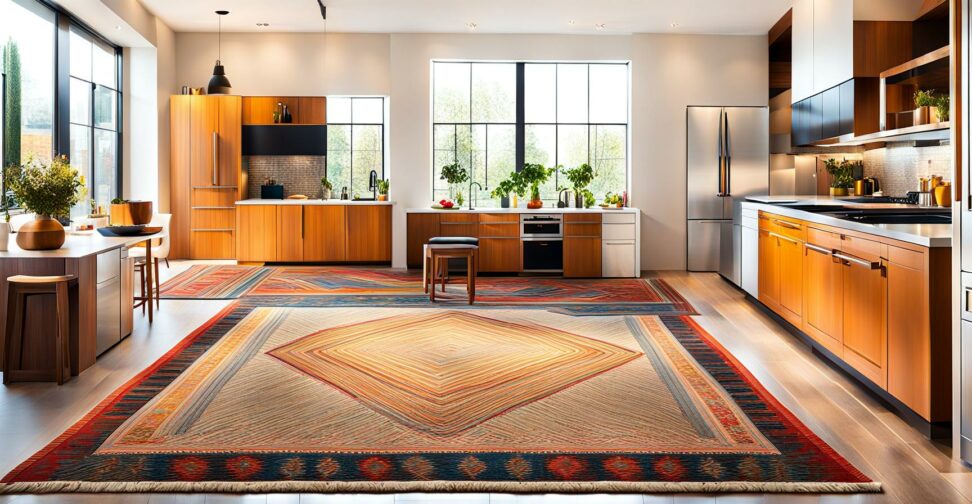Clever Ways to Use Rugs in Your Kitchen
The kitchen is often the heart of the home, where family and friends gather to cook, eat, and spend quality time together. An area rug is a great way to add visual interest and comfort underfoot in this busy living space.
Rugs come in endless colors, patterns, sizes and materials - making them one of the easiest ways to complement your existing kitchen decor. From defining spaces to absorbing sound, a good kitchen rug does double duty form and function.

Define the Kitchen Zones
Most kitchen floor plans include three main zones: cooking, prepping, and eating. The right area rugs can delineate each zone both aesthetically and practically.
Cooking Zone Rugs
The cooking zone near the stove and ovens sees a lot of high-traffic, spills, and splatters. A kitchen rug here takes a beating, so durability is key.
Measuring the space and selecting a properly sized stove area accent rug is crucial. Too small and it slides around, too large can pose a tripping hazard. An anti-slip rug pad is a smart addition for safety and to anchor the rug in place.
For a unified look, use a colorful runner rug to tie together the cooking zone appliances and cabinetry. Natural fiber or rubber-backed rugs withstand heat and stains best.
Prepping Zone Rugs
The prepping zone contains sinks, countertops and islands where you wash, chop, mix and assemble. A water-resistant kitchen mat, cotton rug or durable sisal runner help soak up drips and define the work area.
Measure under cabinets to lay rugs wall-to-wall, or float a medium-sized rectangle rug in the center of the space. Contain messes and cushion your feet as you cook and clean.
Eating Zone Rugs
An eating area rug anchors your kitchen table and chairs, lending a cozy sense of home. Size it to fully fit under table legs, allowing proper clearance when pulling up chairs.
For casual family meals, a machine washable, stain-resistant playmat rug adds practicality. Or make a design statement with an oriental rug under elegant formal dining sets.
Rug Size and Placement
Proper kitchen rug size and placement prevent safety issues like tripping while also being aesthetically pleasing.
For starters, measure each zone you hope to accent with a rug. Standard kitchen rug sizes include 4'x6' for compact prep spaces, 5'x8' under large sinks, and 8'x10' for dining areas. Runners tend to be 2-4 feet wide and 6-10 feet long.
While traditional advice is to keep rugs away from the edges of cabinets and appliances, it’s also trendy to creatively place a rug under part of a table or to cocoon an eat-in nook.
Runner Rug Ideas
Runners excel at defining high traffic walkways in efficient galley style kitchens. A bold patterned rug steering guests from sink to stove to fridge makes a statement. Or try a quirky sliced rug runner using varying grains, colors and textures.
Kitchen runners also work well paired together, such as a cotton one before the sink and a soft but durable synthetic option guiding the path from stove to table.
Area Rug Ideas
For sitting areas like breakfast nooks or zones like an island, medium round rugs 5-6 feet in diameter or square rugs work beautifully. If choosing a rectangle area rug for under dining sets, allow at least 2 feet of clearance on all sides.
On hard surfaces like tile or wood, secure area rugs with a nonslip rug pad. This prevents accidents and buckling while also absorbing noise.
Choose Kitchen Rug Shapes
While most kitchen rugs are rectangular, playing with shape adds an element of interest.
Runner rugs are ideal for galley kitchens. Round and oval rugs define sitting zones without looking out of place. Octagons, scalloped edges and kidney shapes also mix things up in pleasing ways.
If your kitchen layout has a unique footprint, consider a custom-cut rug sized and shaped specifically for your floors. Companies like Ruggable offer washable rugs made to order.
Use Color to Make a Statement
Like any decor choice, kitchen rug color can be tailored to your existing aesthetic - from muted to bold. If your cabinets, walls and accents use a neutral palette, inject color solely through the rugs.
For a monochromatic look, layer a few tones of one color. Green hues, for example, give off an earthy, organic vibe. A bright red stove rug makes that zone pop against dark cabinetry. There are no rules - pick a color scheme that excites you.
Complement Kitchen Style
While braided and rag rugs suit farmhouse kitchens, graphic prints and geometric patterns complement modern spaces. Florals and oriental designs work for traditional kitchen aesthetics.
However, don’t be afraid to juxtapose styles. A vintage Persian rug under sleek stainless appliances can be gorgeous. The key is ensuring each element enhances the overall room harmony.
Mix Various Textures
Beyond colors and patterns, vary rug textures to add tactile interest. Plush shag offers cushioning that active kitchens need. Natural jute and braided rugs provide visual depth.
Combining materials like wool and cotton or sisal and bamboo gives the best of both worlds - softness for comfort yet durable and easy-cleaning constructions.
Safety first when selecting kitchen rugs, especially in wet and high-traffic zones. Look for non-slip rubber backing to prevent slips and falls on hard floors.
Stain resistant materials that easily release spills and are machine washable make upkeep effortless. And for peace of mind, choose rugs made of fire retardant materials.
With the right kitchen rug, this high-functioning space can also be serene and beautiful. Define zones, absorb sound, and bring your aesthetic vision to life. Just take measurements, look for quality materials and placement versatility. With a dash of creativity, your kitchen rugs will both serve you and provide decor inspiration.